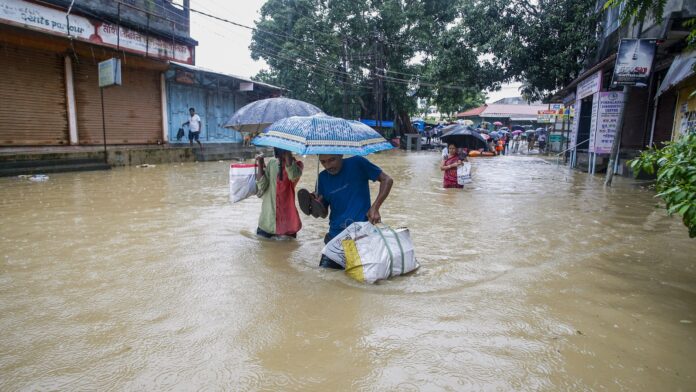
Tripura has been officially declared a ‘Natural Calamity Affected Area’ by the Tripura Disaster Management Authority following devastating floods that have ravaged the state. The announcement comes in the wake of catastrophic flooding that has claimed 31 lives and inflicted damages estimated at Rs. 15,000 crores. The floods, which began as a heavy monsoon downpour, quickly escalated into a crisis, submerging large parts of the state and displacing thousands of residents.
The severe weather event has caused widespread destruction across Tripura, leaving entire communities submerged and infrastructure severely damaged. Roads, bridges, and homes have been washed away, and essential services have been disrupted. The scale of the disaster has overwhelmed local resources, prompting the state government to seek additional support from the central government and various relief organizations.
The impact on daily life has been profound. Many residents are left without access to clean drinking water, and power outages have become common in affected areas. The state has faced challenges in maintaining public health and safety amid the crisis. Emergency shelters have been set up to accommodate those who have lost their homes, but the sheer number of displaced individuals has strained the capacity of these facilities.
In response to the crisis, the Tripura Disaster Management Authority has initiated several relief and rehabilitation efforts. Rescue teams have been deployed to the most affected regions to provide immediate assistance and conduct search and rescue operations. Medical teams are working to address health concerns and prevent the outbreak of diseases in the wake of the floods. The government has also announced financial aid for the affected families, aiming to provide some relief as they begin to rebuild their lives.
The floods have also prompted a call for improved disaster preparedness and response strategies. Experts emphasize the need for better flood management systems and infrastructure to mitigate the impact of such extreme weather events in the future. The state government has pledged to review and enhance its disaster management protocols to better handle similar emergencies in the future.
Public response to the disaster has been marked by widespread solidarity and support. Numerous local and national organizations have stepped in to provide aid and resources to those in need. Volunteers have been working tirelessly to distribute food, clothing, and other essentials to the affected populations. The outpouring of support reflects the collective effort to address the immediate needs of those impacted and to support the long-term recovery process.
The scale of the devastation in Tripura highlights the urgent need for comprehensive disaster risk reduction strategies. As the state begins the process of recovery and rebuilding, there is a growing recognition of the importance of investing in resilient infrastructure and community preparedness. The recent floods serve as a stark reminder of the vulnerabilities faced by many regions in the face of natural disasters and the need for ongoing efforts to enhance disaster resilience.
In the coming weeks, Tripura will continue to face the challenges of recovery and rebuilding. The focus will be on restoring essential services, providing support to displaced individuals, and addressing the extensive damage caused by the floods. The state’s recovery will depend on the coordinated efforts of government agencies, relief organizations, and the resilience of the affected communities.
As Tripura navigates this difficult period, the solidarity and support of the nation will play a crucial role in helping the state recover and rebuild. The commitment to providing relief and addressing the long-term needs of those affected will be key to ensuring that Tripura emerges stronger and better prepared for future challenges.



